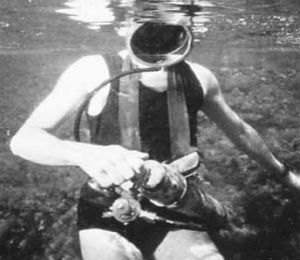Tracing a fascinating progression from ancient Greece to modern times, the history of snorkeling is a tale of man’s love affair with the sea and its myriad of fascinating and colorful creatures. There are so many exciting things to do in Nassau, and snorkeling the many dramatic reefs and romantic wrecks is consistently one of the most popular activities in this tropical paradise.
Second World War and Snorkeling
Snorkeling is a favorite vacation pastime, yet ironically it received one of its most important boosts during World War II, when the United States Navy selected a special group of divers to perform underwater tasks. Known as “frog men”, these divers carried out secret missions in the Pacific Ocean, mainly against the Japanese forces. In order to stay underwater longer, the frog men wore primitive versions of snorkeling masks and scuba tanks, and over time the efficiency and safety of the gear was improved. After the war, similar types of diving gear became popular for leisure pursuits.
FrenchInfluence on Snorkeling
In 1930, French inventor Guy Gilpatric came up with special waterproof swim goggles and the practice of diving underwater to see the sights was born. Not to be outdone, several years later fellow Frenchman Yves le Prieru came up with a device for breathing under water. He called it a “constant flow open circuit breathing apparatus” and when wearing it he could stay under 20 feet of water for over 15 minutes. This primitive but effective gear was the forerunner of modern day snorkeling equipment.
Modern Magic
Once people discovered the joys of peering under the ocean’s surface, modern technology was employed to dramatically improve equipment for breathing underwater. Improved plastic and rubber compounds made it easier to create viable masks and goggles for divers utilizing treated glass for additional safety. The addition of effective types of snorkeling fins made movement through the ocean as easily as a fish, and vast improvements in the snorkel tube allowed adventurers to breathe while face down in the water without getting a mouthful of the ocean.
History of Fins
Snorkeling footwear has presented ongoing challenges. The first patent for fins was granted to Frenchman Louis Marie de Corlieu in 1933, and mass production began in 1939, leading to further increases in the popularity of the fledgling sport of snorkeling. After observing young Tahitian boys weaving mats, dipping them tar, letting them cool and strapping them to their feet, American inventor Owen Churchill decided to try using vulcanized rubber as material for his version of swimming fins. Vulcanized rubber is a cured rubber, meaning it is harder than and not as sticky as natural rubber. Churchill’s design was patented in 1940, but initial sales were less than 1,000; after all, snorkeling hadn’t yet gained the massive popularity it enjoys today.
Designs
Louis le Corlieu is generally credited with the invention of modern fins, patented in 1933, and right around the same time waterproof goggles were also being developed. In 1948, the precursor to today’s full-foot style fin was created by Italian company Cressi-Sub. Called the Rondine, the fin could be slipped on like a shoe. With improved breathing, underwater vision and swimming, the modernization of diving was underway, making it more comfortable and accessible for the average person.
Not only are the clever inventions of fins, goggles and snorkels a source of much joy and excitement on vacation, they are also used as hunting and athletic gear. Underwater rugby and underwater hockey players use the equipment to stay underwater longer, and spear fishermen use them to help catch fish. However, today snorkeling is primarily a favorite form of seaside recreation, and visitors to idyllic islands and shorelines around the world flock to reefs, coves and wrecks for an unforgettable journey through the glorious world beneath the sea.

